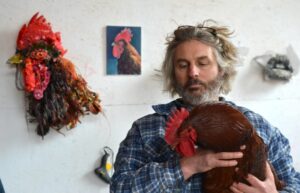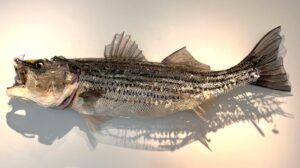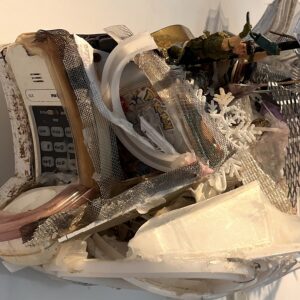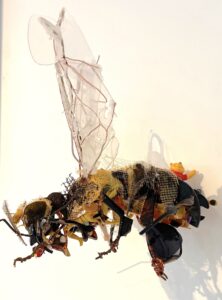Mounted on the wall at Jeff Soderbergh Gallery in Wellfleet is a large striped bass. From a distance, the fish looks natural and seamless — an iridescent specimen with a gaping mouth and a dead-eyed, beady gaze. But on closer examination, the illusion starts to reveal itself.

Artist Tom Deininger assembles his work — including Striped Bass, the piece mounted on the wall of the gallery — from a wide-ranging palette of found materials. On trash day, he says, he rummages through people’s garbage cans in the neighborhood near his studio in Tiverton, R.I.
“I dumpster dive,” says Deininger. “I go to parking lots; I do beach cleanups. I’m always picking things up and putting them in my pockets.” The things he finds — old cassette tape cases, bits of wire and fabric, empty syringes, abandoned plastic toys — become elements of his detailed sculptures. Most of them depict fish, birds, and insects, which are among the creatures Deininger says are most threatened by human-caused environmental degradation.
The open mouth of Striped Bass is an old cell phone. Its glistening body is a multi-dimensional network of plastic and wire. The fuzzy yellow body of Bee is made from plastic bristles, netting, and toy figurines, including Shaggy and Scooby-Doo, a German shepherd, and a little man holding a long stick. The bee’s eye is a lens from a pair of sunglasses. There’s a bin full of old sunglasses in his studio. “I’m drowning in stuff,” he says, as we all are — part of what he calls “our environmental irresponsibility,” which he finds impossible to ignore.

Deininger’s sculptures are meant to be disconcerting. “There is a confidence that we understand our world,” he says. As his creations dissolve into their disparate materials before the viewer’s eye, he hopes that confidence is replaced by unease. “What we thought we knew comes apart.”
His art, he says, isn’t meant to be preachy. But it does offer an idea: “There’s so much junk around us that we can recreate the natural world.”
Deininger wasn’t always an assemblage artist. As a “distractible” child, he liked to draw. He spent a lot of time outdoors in Norwell, the town where he grew up, and in Marshfield, where his grandfather had a house. “I was always in the water,” he says.
When he got older, he started painting. In his early 20s, he went on an “endless summer surf trip” to Fiji and other islands where he witnessed the accumulation of trash and became uncomfortably aware of the effects of a lifestyle dominated by consumerism. At the same time, he began looking more closely at the artists he idolized.

“I had a real thing for John Singer Sargent and Diego Velázquez,” he says. “They could do so much with so few strokes.
“If you look at a painting by Sargent, it’s completely abstract up close,” says Deininger. “When you step back, you see everything.” That kind of illusive artistry, he says, “where you have abstraction and representation at the same time, that’s something I was after.” He started adding texture to his paintings: rope and plastic and packaging. “It dawned on me that there really isn’t a difference whether I make a red mark or a red line or use a piece of hose.”
Over time, Deininger’s paintings began to protrude from their canvases, breaking out of the confines of two dimensions. “I think a lot of the time, artists create problems for themselves to solve,” says Deininger. The problem was his paintings needed more space. The solution was one that would come to define his art practice: “I wonder if I could build one of these entirely out of little found objects.”
Deininger’s sculptures are cluttered until they’re clear: chaos becomes catharsis. The process of creating them, he says, “is almost like a free form of jazz.” While he has an ending in mind for his work, the path to get there is full of useful inversions and unexpected dissonance.

“Sometimes I’ll build something, and I’ll get very close to what I want,” he says, “but I’ll realize there’s a better way to do it. I’ll rip the whole thing apart and refactor the various pieces so they work better.”
Deininger says that the question of whether he first imagines an image he’d like to create and then looks for the junk to build it or if he begins with finding materials that inspire a particular sculpture is as paradoxical and irrelevant as the question “Which came first, the chicken or the egg?” Both elements are part of the same process and cannot be extricated from it.
For example, when Deininger decides he wants to make a piece based on a particular bird — a kingfisher, say — he’ll start by birdwatching. He’ll read and watch videos about the species and learn the spectrum of their color and size and the differences in behavior between males and females. “It’s an opportunity to be curious about the world,” he says.
He followed a similar process making a piece based on bees. “To cull through hundreds of images of bees and find the one you want because you can clearly see the eye or the thorax — you get to understand the granular details of variation within a species,” he says.

Researching his subjects happens simultaneously with finding objects to depict them. Deininger says his search for the materials occurs in a sort of “dream state.”
“It’s a little weird,” he says. “You start seeing all these little pieces of animals that you’re familiar with in ordinary objects around you. It just so happens that a bait net from a lobster trap, washed up on the shore and bleached in the sun, makes an exactly perfect feather structure for a robin’s chest.”
In the end, Deininger’s search for materials is just one piece of the bigger picture. “A big part of being an artist,” he says, “is asking yourself, ‘What do you want to look at? What do you want to stare at? What do you want to obsess over? What do you want to meditate on?’ ”
